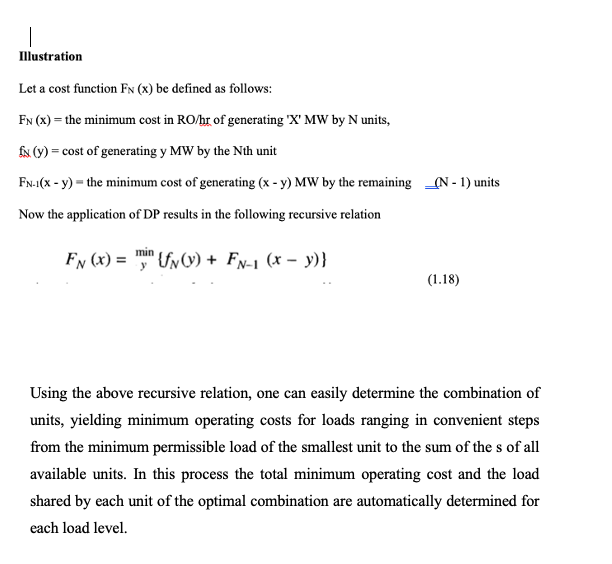Home /
Expert Answers /
Electrical Engineering /
explain-the-dynamic-programming-process-of-unit-commitment-in-the-form-of-a-flow-chart-all-7-steps-pa146
(Solved): Explain the Dynamic Programming process of Unit Commitment in the form of a flow chart (all 7 Steps) ...
Explain the Dynamic Programming process of Unit Commitment in the form of a flow chart (all 7 Steps).
Dynamic programming method
Considerable computational saving can be achieved by using Dynamic programming method for comparing the economics of combinations as certain combinations need not be tried at all[3].
Algorithm:
1. The total number of units available, their individual cost characteristics and the load cycle on the station are assumed to be known a priori
2. It is assumed that the load on each unit or combination of units changes in suitably small but uniform steps of size \delta MW (e.g.1MW).
3. Starting arbitrarily with any two units, the most economical combination is determined for all the discrete load levels of the combined output of the two units.
4. At each load level the most economic answer may be to run either unit or both units with a certain load sharing between the two.
5. The most economical cost curve in discrete form for the two units thus obtained, can be viewed as the cost curve of a single equivalent unit.
6. The third unit is now added and the procedure repeated to find the cost curve of the three combined units. Note: In this procedure the operating combinations of third and first also third and second are not required to be worked out resulting in considerable saving in computational effort.
7. The process is repeated, till all available units are exhausted.
Note: The advantage of this approach is that having obtained the optimal way of loading k units, it is quite easy to determine the optimal manner of loading (k+1) units.
Illustration
Let a cost function F_(N) ( x ) be defined as follows:
F_(N)(x)= the minimum cost in R(O)/(h)r of generating ' X ' MW by N units,
f_(N)(y)= cost of generating y MW by the Nth unit
F_(N-1)(x-y)= the minimum cost of generating (x-y)MW by the remaining
(N - 1) units
Now the application of DP results in the following recursive relation
F_(N)(x)=min_(y){f_(N)(y)+F_(N-1)(x-y)}
Using the above recursive relation, one can easily determine the combination of
units, yielding minimum operating costs for loads ranging in convenient steps
from the minimum permissible load of the smallest unit to the sum of the s of all
available units. In this process the total minimum operating cost and the load
shared by each unit of the optimal combination are automatically determined for
each load level.